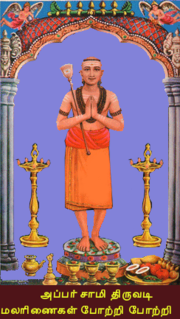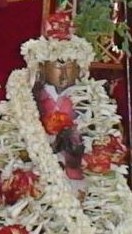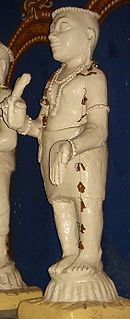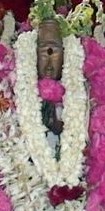
Sambandar, also referred to as Thirugnana Sambandar, Tirujnanasambanda, Campantar or Ñāṉacampantar, was a Saiva poet-saint of Tamil Nadu who lived sometime in the 7th century CE. He was a child prodigy who lived just 16 years. According to the Tamil Shaiva tradition, he composed an oeuvre of 16,000 hymns in complex meters, of which 383 (384) hymns with 4,181 stanzas have survived. These narrate an intense loving devotion (bhakti) to the Hindu god Shiva. The surviving compositions of Sambandar are preserved in the first three volumes of the Tirumurai, and provide a part of the philosophical foundation of Shaiva Siddhanta.

The Periya Puranam, that is, the great purana or epic, sometimes called Tiruttontarpuranam, is a Tamil poetic account depicting the lives of the sixty-three Nayanars, the canonical poets of Tamil Shaivism. It was compiled during the 12th century by Sekkizhar. It provides evidence of trade with West Asia The Periya Puranam is part of the corpus of Shaiva canonical works.

Appar, also referred to as Tirunāvukkarasar or Navukkarasar, was a seventh-century Tamil Śaiva poet-saint. Born in a peasant Śaiva family, raised as an orphan by his sister, he lived about 80 years and is generally placed sometime between 570 and 670 CE. Appar composed 4,900 devotional hymns to the Hindu god Shiva, out of which 313 have survived and are now canonized as the 4th to 6th volumes of Tirumurai. One of the most prominent of the sixty-three revered Nayanars, he was an older contemporary of Thirugnana Sambandar.

The Thevaram, also spelled Tevaram, denotes the first seven volumes of the twelve-volume collection Tirumurai, a Śaiva narrative of epic and puranic heroes, as well as a hagiographic account of early Saiva saints set in devotional poetry. The Thevaram volumes contain the works of the three most prominent Saiva Tamil poets of the 7th and 8th centuries: Sambandar, Appar, and Sundarar. The three poets were not only involved in portraying their personal devotion to Shiva, but also engaged a community of believers through their songs. Their work is an important source for understanding the Śaiva Bhakti movement in the early medieval South India.

Pusalar is an eighth-century Nayanar saint, venerated in the Hindu sect of Shaivism. He is generally counted as the fifth-eighth in the list of 63 Nayanars. His hagiography speaks how he created a grand temple for Shiva in his mind and how his patron god Shiva preferred attending the consecration of his mind temple, instead of a grand temple created by a Pallava king.
Dandi Adigal Nayanar or Dandiyadigal Nayanar is the 31st Nayanar saint. Traditional hagiographies like Periya Puranam and Thiruthondar Thogai describe him as a great devotee of the Hindu god Shiva.
The impalement of the Jains is an alleged 7th-century event, first mentioned in an 11th-century Tamil language text of Nambiyandar Nambi. According to this hagiographic text, Jain monks allegedly persecuted the 7th-century Shaivite child-saint Sambandar and tried to kill him. When that failed, they challenged him to a philosophical debate. Sambandar defeated the Tamil Jain monks in a series of debates and contests on philosophy, thereby converted a Jain Pandyan king to Shaivism. The episode ended with the impalement of 8,000 Tamil Jains or Samanars as they were called. According to the early version of the legend, the Jains voluntarily impaled themselves in order to fulfill their vow after losing the debate. According to a later version of the legend found in Takkayakapparani – a war poem, the newly converted king ordered the Jains to be impaled at Sambandar's instigation. The Pandyan king, variously called "Koon Pandiyan" or "Sundara Pandyan" in the legend is identified with the 7th century ruler Arikesari Maravarman.

Sakkiya Nayanar was a Nayanar saint, venerated in the Shaiva sect of Hinduism. He is generally counted as the thirty-fourth in the list of 63 Nayanars. He was a crypto-Hindu posing as a Buddhist, practicing Shaivam in secrecy. He was reported to have worshipped Lord Shiva, his patron god, by hurling stones at his iconography.
Idangazhi (Idangali), also known as Idangazhi Nayanar, Idangaliyar (Idankaliyar) was a Nayanar saint, venerated in the Hindu sect of Shaivism. He is generally counted as the fifty-fourth in the list of 63 Nayanars. He was an Irukku Velir chieftain, who is described to not only have pardoned a devotee of the god Shiva, who stole from the royal granaries, but also distributed rice to devotees of Shiva.
Satti Nayanar, also known as Satti (Sathi), Sathiyar, Shakti Nayanar, Shakti, Shaktiyar (Saktiyar), Sattiyandar and Thiru-Saththi Nayanar, is a Nayanar saint, venerated in the Hindu sect of Shaivism. He is generally counted as the 45th in the list of 63 Nayanars. Satti Nayanar is described to cut off the tongue of whoever talked ill of his patron god Shiva or Shiva's devotees.
Kungiliya Kalaya Nayanar, also known as Kungiliya Kalaya, Kalayar, Kunguliya and Kalaya Nayanar, is a Nayanar saint, venerated in the Hindu sect of Shaivism. He is generally counted as the eleventh in the list of 63 Nayanars.

Murkha Nayanar, also known as Moorka Nayanar, Murka Nayanar, Moorkha Nayanar, Murgga Nayanar, Moorkka Nayanar and Murkhar, is a Nayanar saint, venerated in the Hindu sect of Shaivism. He is generally counted as the thirty-second in the list of 63 Nayanars.

Nami Nandi Adigal, also spelt as Naminandi adigal, Naminandi adikal and Naminanti Atikal, and also known as Naminandi and Naminandhi, is a Nayanar saint, venerated in the Hindu sect of Shaivism. He is generally counted as the 27th in the list of 63 Nayanars.

Somasi Mara Nayanar, also known as Somasi Maranar, Somasi Marar, Somasimarar and Somasira Nayanar, is a Nayanar saint, venerated in the Hindu sect of Shaivism. He is generally counted as the thirty-third in the list of 63 Nayanars. He is also called Marar, Maran and Mara Nayanar, names he shares with Ilayankudi Mara Nayanar. The two Nayanars are generally differentiated by the prefixes "Somasi" and "Ilayankudi". He was a contemporary and devotee of Sundarar.

Isaignaniyar, also spelt as Isainaniyar, Isaignaniyaar, Isaignaniar and Isaijnaniyar and also known as Isai-jnani Ammaiyar, is the mother of Sundarar, one of the most prominent Nayanar saints. She is herself regarded as a Nayanar saint, venerated in the Hindu sect of Shaivism, along with her husband Sadaiya Nayanar. She is generally counted as the last in the list of 63 Nayanars.

Sadaiya Nayanar or Sadaiyar is a 7th century Nayanar saint in the Hindu sect of Shaivism, venerated for being father of the prominent saint Sundarar rather than for individual merit. He and his wife Isaignaniyar are generally counted as sixty-second and sixty-third on the list of the sixty-three Nayanar saints. Sundarar is the only Nayanar with both parents venerated.
Eyarkon Kalikkama Nayanar, also known as Eyarkon Kalikama Nayanar, Kalikkama Nayanar, Kalikamba Nayanar, Kalikkamar, Kalikamar, Kalikkambar, Yeyarkon Kalikkamar and Eyarkon Kalikkamar, is a Nayanar saint, venerated in the Hindu sect of Shaivism. He is generally counted as the 29th in the list of 63 Nayanars.

Eripatha Nayanar, also known as Eripathar, Eripatar, Eribattar, Eripattan', Eripaththa Nayanar and Eripattha Nayanar, is Nayanar saint, venerated in the Hindu sect of Shaivism. He is generally counted as the eighth in the list of 63 Nayanars.

Pugal Chola, also known as Pukal Chola, Pukazhchozha Nayanar, Pugazh, Pukazhcchozhar, Pukal Cholan and Pugal Chola Nayanar, is described as a Chola ruler and was a Nayanar saint, venerated in the Hindu sect of Shaivism. He is generally counted as the eighth in the list of 63 Nayanars.

Kutruva Nayanar, also known as Kootruva , Kutruva, Kutruvar, Kootruvar, Kurruva Nayanar, Kurruvar, Kurruvan, Kutruvanar, Kurrrruvar, Kalappallan and Kalappalar, was a chieftain of Kalandai and a Nayanar saint, venerated in the Hindu sect of Shaivism. He is generally counted as the 39th in the list of 63 Nayanars. Kutruva is often described as a Jain, who became a devotee of Shiva, the patron god of Shaivism.










